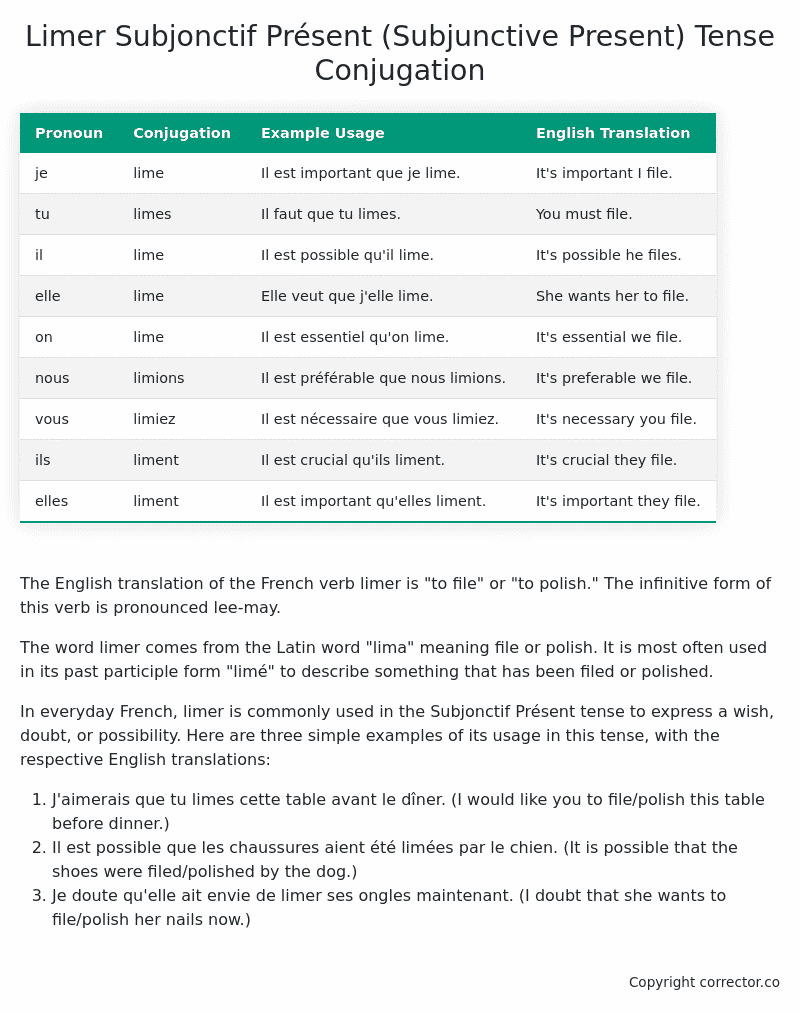Subjonctif Présent (Subjunctive Present) Tense Conjugation of the French Verb limer
Introduction to the verb limer
The English translation of the French verb limer is “to file” or “to polish.” The infinitive form of this verb is pronounced lee-may.
The word limer comes from the Latin word “lima” meaning file or polish. It is most often used in its past participle form “limé” to describe something that has been filed or polished.
In everyday French, limer is commonly used in the Subjonctif Présent tense to express a wish, doubt, or possibility. Here are three simple examples of its usage in this tense, with the respective English translations:
- J’aimerais que tu limes cette table avant le dîner. (I would like you to file/polish this table before dinner.)
- Il est possible que les chaussures aient été limées par le chien. (It is possible that the shoes were filed/polished by the dog.)
- Je doute qu’elle ait envie de limer ses ongles maintenant. (I doubt that she wants to file/polish her nails now.)
Table of the Subjonctif Présent (Subjunctive Present) Tense Conjugation of limer
| Pronoun | Conjugation | Example Usage | English Translation |
|---|---|---|---|
| je | lime | Il est important que je lime. | It’s important I file. |
| tu | limes | Il faut que tu limes. | You must file. |
| il | lime | Il est possible qu’il lime. | It’s possible he files. |
| elle | lime | Elle veut que j’elle lime. | She wants her to file. |
| on | lime | Il est essentiel qu’on lime. | It’s essential we file. |
| nous | limions | Il est préférable que nous limions. | It’s preferable we file. |
| vous | limiez | Il est nécessaire que vous limiez. | It’s necessary you file. |
| ils | liment | Il est crucial qu’ils liment. | It’s crucial they file. |
| elles | liment | Il est important qu’elles liment. | It’s important they file. |
Other Conjugations for Limer.
Le Present (Present Tense) Conjugation of the French Verb limer
Imparfait (Imperfect) Tense Conjugation of the French Verb limer
Passé Simple (Simple Past) Tense Conjugation of the French Verb limer
Passé Composé (Present Perfect) Tense Conjugation of the French Verb limer
Futur Simple (Simple Future) Tense Conjugation of the French Verb limer
Futur Proche (Near Future) Tense Conjugation of the French Verb limer
Plus-que-parfait (Pluperfect) Tense Conjugation of the French Verb limer
Passé Antérieur (Past Anterior) Tense Conjugation of the French Verb limer
Futur Antérieur (Future Anterior) Tense Conjugation of the French Verb limer
Subjonctif Présent (Subjunctive Present) Tense Conjugation of the French Verb limer (this article)
Subjonctif Passé (Subjunctive Past) Tense Conjugation of the French Verb limer
Subjonctif Imparfait (Subjunctive Imperfect) Tense Conjugation of the French Verb limer
Subjonctif Plus-que-parfait (Subjunctive Pluperfect) Tense Conjugation of the French Verb limer
Conditionnel Présent (Conditional Present) Tense Conjugation of the French Verb limer
Conditionnel Passé (Conditional Past) Tense Conjugation of the French Verb limer
L’impératif Présent (Imperative Present) Tense Conjugation of the French Verb limer
L’infinitif Présent (Infinitive Present) Tense Conjugation of the French Verb limer
Struggling with French verbs or the language in general? Why not use our free French Grammar Checker – no registration required!
Get a FREE Download Study Sheet of this Conjugation 🔥
Simply right click the image below, click “save image” and get your free reference for the limer Subjonctif Présent tense conjugation!

Limer – About the French Subjonctif Présent (Subjunctive Present) Tense
Formation of the Subjonctif Présent
Common Everyday Usage Patterns
Interactions with Other Tenses
Summary
I hope you enjoyed this article on the verb limer. Still in a learning mood? Check out another TOTALLY random French verb conjugation!


